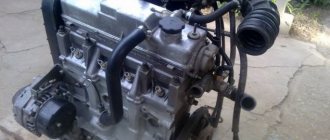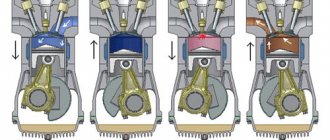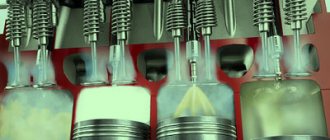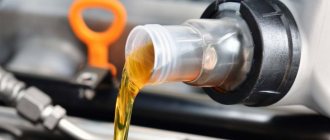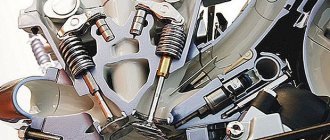The operating principle of diesel power units is based on the ignition of the fuel mixture in the cylinders under high pressure. Unlike a gasoline engine, a diesel engine does not have a spark supply system using electrode tips on spark plugs: an oxygen-enriched mixture is supplied to the combustion chamber, where high temperature is generated during the compression process. Instead of generating an electric spark, additional pre-heating is provided by glow plugs.
The main parameter for diagnosing the condition of a diesel engine is compression, on which the power and stable operation of the mechanisms of the cylinder-piston group depend.
What is compression in a diesel engine
Compression is an indicator of the pressure in the cylinder that is created by the piston at the maximum highest (dead) point of the stroke. In technical literature, it is customary to use the abbreviation TDC (highest dead center). The value is measured in kg/cm² and depends on two main factors:
- Violation of the tightness of the combustion chamber: air leaks, pressure in the system drops. Worn valves, cylinder-piston units, or incorrect adjustment of the gas distribution mechanism leads to a decrease in compression.
- Condition of the crankshaft and its rotation speed: loss of stable speed leads to heat losses when air is compressed by the piston. The compression ratio becomes lower than normal, which directly affects the energy that is generated as a result of the formation of working gases during the combustion of the fuel mixture in the cylinders.
Rapid wear of CPG mechanisms (cylinder-piston group) depends on the quality of lubricants, the intensity of loads during operation, the number of cold starts at sub-zero air temperatures and hours of operation at maximum speed. Incorrect adjustment of the valve system contributes to the formation of carbon deposits on the walls of the combustion chamber, cylinder liners, and coking of the piston and oil scraper rings. As a result of insufficient pressure, the fuel mixture does not burn completely and mixes with oil residues, leaving burning products and soot on the CPG units. The first sign of wear in this case is a smoky exhaust and a drop in engine power.
During startup and activation of the starter, the crankshaft in a diesel unit rotates at a speed of 200-300 rpm: the higher the torque, the higher the compression. If the pressure in the combustion chamber is below 16 atmospheres, then starting the diesel engine in the usual way with the key becomes impossible. Heat loss causes a decrease in the compression ratio and disruption of the valve timing adjustment.
Important! Prolonged operation of a diesel unit with incorrect operation of the gas distribution mechanism leads to failure of the entire cylinder block. Up to the jamming of the pistons without the possibility of restoration and major repairs.
Theory
In order to avoid such errors, it is worth getting acquainted with the theory. In addition to compression in the cylinders, there is also another value called the compression ratio. The compression ratio is just a geometric value that reflects the relationship of the combustion chamber between the head and the piston at its positions at top and bottom dead center.
Usually this value is stable and cannot change during normal operation of the engine. It can be changed by boring the engine or, conversely, installing a thicker gasket. It is worth noting that this value is greater than that of gasoline engines.
So it turns out that most often these two concepts are confused, although compression is a physical quantity, measured in kilograms per square centimeter, pci or bars and, in fact, is the pressure that is created in the engine cylinders when the piston operates. The compression amount is always greater than the compression ratio.
This arises accordingly as a result of the action of physics. As the piston passes through the cylinder, friction occurs, which results in heating. And it turns out that this same energy is given not to the metal, but to the air that is in the cylinder. The air increases in volume, the pressure increases, so the compression ratio will always be less than the compression on a diesel engine, and on a gasoline engine too.
Compression rate in diesel engine cylinders
Depending on the power of the power unit, the type of design of its combustion chamber and injection system, the compression rate may be different. It must be looked for in the technical description of each specific brand. Below are the standard indicators for the ratio of starting temperature and compression at which starting a diesel engine of any type is possible:
- Less than 18 kg/cm² – engine starting is impossible even with forced heating of the system;
- 22-24 kg/cm² – starting is possible only on a hot unit; after the temperature drops below 0° C, failure to start from the starter is guaranteed;
- 24-26 kg/cm² – starts at air temperature – 10° C;
- 26-28 kg/cm² – maximum starting temperature – 15° C;
- 28-32 kg/cm² – cold start possible down to – 25° C;
- 32-36 kg/cm² – cold start possible down to – 30° C;
- 36-40 kg/cm² – cold start up to – 40° C is possible.
These compression standards are applied only if all other systems responsible for engine operation are in good working order: fuel supply (high pressure fuel pump), 100% battery charge, serviceable timing components. Modern types of diesel engines with a separate combustion chamber and a Common Rail fuel injection system have better results: for each compression indicator there will be an average of plus five temperature values. The error also increases with the number of cylinders in the unit and the type of layout: V-shaped ones with 6 and 8 cylinders have a greater advantage over conventional in-line four-cylinder ones.
Important:
The coefficient of filling the combustion chamber with air at the maximum compression ratio and sufficient pressure (compression) creates the operating ignition temperature of the fuel mixture.
What should the compression level be?
There are many engines with their own characteristics. And it is impossible to say exactly how much compression should be in the engine; there is no universal figure - it is individual for each power unit.
The compression value is calculated according to the principle: compression ratio*multiplying factor (the so-called X number).
The compression ratio and the mentioned coefficient depend on the individual characteristics of the motor.
Important: the level of compression in any diesel engines is much higher than in their gasoline counterparts, since the fuel is ignited by adding it to air heated by high pressure. But even here it is impossible to say what the compression should be in a diesel engine; this parameter is also individual.
The nominal value of the compression number is influenced by the type of fuel for which the engine was designed: gasolines with different octane numbers detonate under different operating conditions. Therefore, if, for example, an internal combustion engine designed for 80 gasoline, with a standard 92 or 95 gasoline, it may simply not start, and vice versa, because the engine does not create the conditions required for a normal ignition cycle.
A table of indicators showing what compression should be in the engine for some foreign cars:
For domestic ones, it is approximately in the same values. What is normal compression in diesel engines?
What compression should be in a diesel engine also depends on the unit. The figure for diesel engines is higher; in general, it should not be lower than 23 kg. per sq. cm.
How to measure cylinder pressure
Compression readings are taken using a special device - a compression meter. The compression gauge works on the principle of a pressure gauge: an adapter with an injector or glow plug tip design is designed to be installed in the cylinder head and has a shut-off valve that prevents pressure loss during measurements. Simple devices are equipped with a regular scale with an arrow, more precise professional devices are electronic digital or synchronized with a computer.
Attention! The compression meter must be calibrated with an accuracy of 0.1 kgf/cm² - otherwise the measurement results will not meet the standards.
Before the measurement, the diesel engine is warmed up at maximum speed to the operating oil temperature, the operation of the starter and the state of charge of the battery is checked at 100%. Each cylinder is measured separately.
Measurement technique
To measure the compression of a diesel engine, you will need some special equipment.
When taking measurements, you will need a compression gauge - a version of a pressure gauge adapted to measure the pressure inside the cylinders. How to measure compression? The work consists of the following stages:
- First you need to remove the glow plug or injector on one of the cylinders.
- Instead, a pressure gauge fitting is screwed in.
- The crankshaft is rotated using the starter, at which time the pressure readings are recorded. The starter must provide at least 200 rpm.
- The pressure gauge is disconnected and the check is carried out similarly in all other cylinders. Normally, the measurement results should be approximately the same in all cylinders.
- The spark plugs or injectors are unscrewed again and 50 ml of engine oil is injected into each cylinder through the hole.
- The engine is cranked by the starter with the spark plugs or injectors removed. After this, the compression in all cylinders is checked again.
Before measuring the compression of a diesel engine, it must be warmed up to operating temperature.
If the indicator has changed upward, it means that parts of the connecting rod and piston group in the cylinders of the diesel engine are wearing out.
If the compression indicators are the same, then the gas distribution mechanism (valve thermal clearances) should be adjusted.
After making the necessary adjustments, it is necessary to check the compression again and troubleshoot the auxiliary equipment.
Why might compression decrease?
A drop in cylinder pressure is accompanied by the following characteristic symptoms:
- failure to start the engine at low temperatures or poor operation of the ignition system;
- during operation at idle speed, “triple” occurs;
- drop in power with unstable speed;
- increased fuel consumption;
- excessive oil consumption;
- foreign impurities in exhaust gases (smoky exhaust);
- strong noise, vibration when opening the throttle.
Reduced compression occurs due to air leaks in the gas distribution mechanism system, cylinder block, or wear of elements and assemblies of the cylinder-piston group. The timing belt may not work correctly due to the formation of carbon deposits on the valve cups or breakdown of the drive mechanisms (springs, seats). To identify a specific cause, the valve system is diagnosed - the valve clearances are measured.
In case of wear of parts of the cylinder-piston group (cylinder-piston group), dismantle the cylinder head in order to find the worn piston cup, gaskets, piston rings or working surface of the cylinders. Burnouts and cracks on the head housing can be determined visually.
How can you determine a possible reduction in compression?
There are several signs by which you can find out about its decline.
- Difficulty starting (both cold and hot).
- Failure of one of the cylinders, misfire
- Abrupt changes in speed, their unevenness.
- Reduced power, failures during operation.
- Overheating of the power unit, increasing pressure in the cooling system.
- Blue smoke from the exhaust pipe upon startup.
- Increased noise during operation, vibration at any speed, especially minimum.
- Oil leaks on the surface of the power unit.
- Significant increase in fuel consumption.
The appearance of at least one of these signs indicates the need to measure the compression of a diesel engine
Troubleshooting solutions
If low compression is detected, a full check of all systems is carried out. Modern diagnostic methods using a special “G‑Scan” scanner make it possible to determine the cause of a breakdown with precision down to a specific component based on the analysis of fuel mixture data, compression values and various sensor readings. The scanner takes into account the ECM (electronic engine control system) log entries, where deviations in the operation of the systems are detailed, all failures in the timing mechanisms are taken into account according to error codes.
On-board computer diagnostics will provide accurate identification of violations that may be missed during a visual inspection. For example, in the process of insufficient supply of the fuel mixture to the cylinder due to a violation of the clearance of a valve, the block controller, based on the readings of the oxygen sensor, regulates additional injection to a specific cylinder, giving a command to the actuator. During a routine check with measuring the clearances of all valves, it may be impossible to determine the cause of carbon deposits in a specific area.
The reason for the decrease in pressure may be due to a slight air leak, when a simple adjustment or replacement of the gasket is sufficient to correct it. In case of serious wear of important CPG mechanisms, a major overhaul of the engine will be required.
What to do if compression decreases
How to increase compression?
Low performance is usually a consequence of wear and tear due to high mileage. Just like a gasoline engine, such a diesel engine is often subject to major repairs, namely: replacing the connecting rod and piston group, grinding in valves, and replacing cylinder head gaskets. Even if a diesel engine compression test shows a decrease in only one or more of them. However, costly repairs can be slightly delayed by using special means to increase compression. These are, first of all, various additives that are added when changing oil for diesel engines. They modify its initial composition and increase its viscosity characteristics, thus minimizing pressure leaks through the compression rings and increasing compression. Also, to increase pressure and reduce leaks, valves are ground in.
Repairing diesel engines is much more expensive due to design features and high technical requirements for diagnostics and special equipment. Therefore, it is important to regularly measure the compression of a diesel engine in order to prolong its performance using timely preventive measures.
How to start an engine with insufficient compression
At low compression rates, the diesel unit does not start by turning the starter normally. If the start is made at sub-zero temperatures on a cold engine, then more force is required for normal crankshaft rotation speed, since the oil becomes more viscous in cold weather. To heat the cardan, use a regular blowtorch, which is installed below and heats the engine systems with hot air.
You can also artificially increase compression for a one-time cold start by creating an oil film in the cylinders. To do this, turn out the glow plugs or injectors and pour motor oil using a syringe directly into the combustion chamber, with a volume of no more than 50 ml. Repeat the entire procedure on each cylinder separately. Afterwards, rotate the crankshaft so that a uniform oil film forms on the walls, which will ensure the creation of a tight seal during start-up. Using this method, you need to monitor the distribution of oil in the cylinder; before starting the engine, the piston must make several strokes with the starter to avoid hydrocline.
The role of compression
If the pressure at the end of the stroke is high, then the gases of the burned fuel remain in the combustion chamber of the cylinder, and a smaller amount escapes into the crankcase. Consequently, the internal combustion engine can perform a greater amount of useful work, and this directly affects the consumption of fuel and lubricant, stability of operation and throttle response.
If compression disappears completely or drops, the driver begins to feel power loss, unstable operation, traction disappears, and the car loses dynamics. Gasoline consumption increases, and the level of engine oil in the crankcase constantly decreases. If a car owner encounters these symptoms, it is necessary to go for diagnostics; perhaps it is a compression problem.
Compression gauge for diesel engines - why is it necessary?
Why is the compression of a diesel engine measured? There are two reasons:
Compression is measured on both gasoline and diesel engines, but fewer requirements and attention are paid to the indicators obtained for a gasoline engine; some shortcomings in the numbers are not paid attention to, because such engines have their own nuances that do not affect the “heart rate.” » car health. But for diesel engines, these nuances become significant, so this process is carried out more often and more thoroughly, and any deviation from the norm allows us to talk about problems in the main mechanism of the car. The very concept of compression, on the one hand, means a physical quantity, and not a process or phenomenon, and characterizes the level of pressure created in the cylinders. The standard condition is that the power is off (only the starter is running). On the other hand, it is considered an indicator of the maximum pressure that the air reaches in the combustion chamber, approaching the upper critical point, called the “dead” point.
A little about geometry
Often, even experienced experts and mechanics confuse the definition of compression and the actual compression ratio, but in reality these are completely different things and all this should be understood in detail.
As for the degree of compression, this value is relative and does not have any strictly defined unit of measurement. The fact is that this indicator includes two characteristics, that is, the volume of each cylinder and the combustion chamber itself. It can show in what proportion the volume and pressure of the fuel mixture or gases will decrease at the moment when the piston rises up.
If you pay attention to the characteristics of modern engines, then most often manufacturers indicate their compression ratio. This characteristic clearly indicates the perfection of the design, as well as the level of boost
The compression ratio and the compression ratio are inextricably linked. It is easy to understand that the compression ratio will be greater if the compression is not lower than it should be. You can find out what it should be like for a particular motor from its technical characteristics. No difficulties would arise if heating of the mixture, changes in oil pressure and other factors were not present during operation of the power unit.
Why does compression drop?
When gases from the cylinder escape into the crankcase, they do not do all the work that they should normally do. The fall manifests itself:
- poor engine starting in any conditions;
- power dips, floating speed;
- black exhaust from the muffler;
- knocks from the engine, pops, etc.
Common reasons for decline:
- the appearance of carbon deposits on the surface of the cylinder (or several) of the internal combustion engine;
- burnout of engine pistons, valves;
- the appearance of cylinder head cracks;
- failed cylinder head gasket;
- dirty air filter, and other reasons.
All of them require careful diagnosis and replacement of damaged parts (but, as mentioned above, overhauls are not always necessary). To determine the causes, car service centers use a complex compression-vacuum method that measures both pressure and vacuum in the cylinder.
How to correctly measure compression on diesel and gasoline internal combustion engines
Why is the normal level of compression (compression pressure) of gasoline and diesel engines so important?
Compression pressure is the main and most important indicator of the smooth operation of a piston internal combustion engine. Compression reduces wear. As compression decreases, engine power decreases
and fuel and oil consumption increases, as well as gas crankcase ventilation increases, and this leads to faster contamination of other engine elements - the intake manifold, throttle and exhaust gas recirculation (EGR) system.
